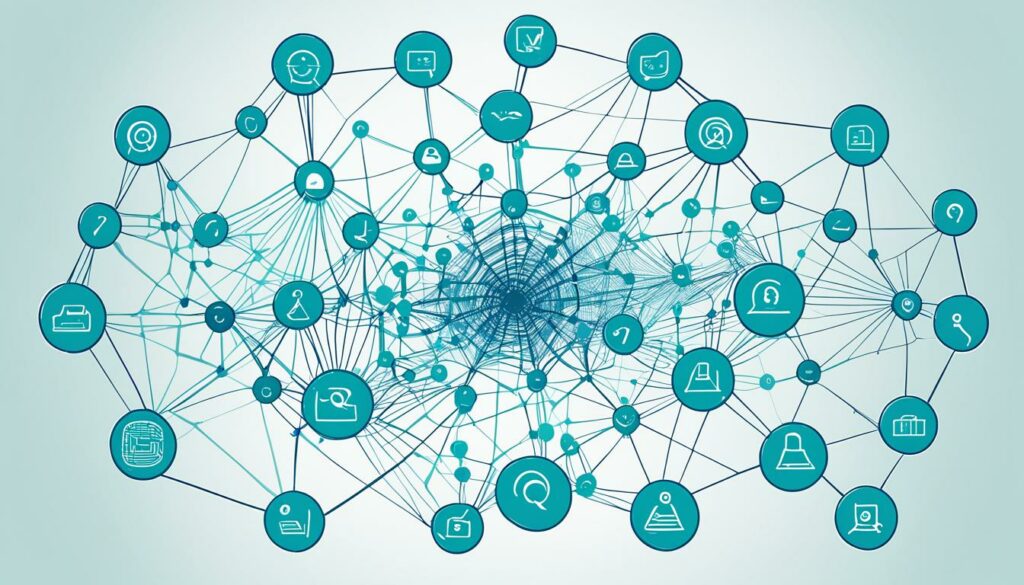
How to Create an AI Chatbot Online: A Step-by-Step Guide for Businesses
Imagine your business helping customers 24/7, answering questions, and solving problems instantly. No need for humans. This is the power of AI chatbots, and it’s possible now. With Chatrobot.me, creating a chatbot is easy, no coding is needed. It’s a must for small business owners to keep up.
This guide will walk you through making your own AI chatbot. You’ll learn how to use AI to make customers happier and operations smoother. It’s all about making your business better.
Key Takeaways
- AI chatbots can improve customer engagement by providing instant responses.
- Creating a chatbot online can be done easily without any coding experience.
- Defining the chatbot’s purpose is crucial for effective implementation.
- The personality and tone of the chatbot should align with your brand.
- Integrating essential features enhances the chatbot’s efficiency.
- Monitoring and optimizing chatbot performance ensures ongoing improvement.
Understanding the Importance of AI Chatbots for Businesses
AI chatbots are now key for businesses looking to boost their operations. They help improve customer service and automate business tasks. Chatbots can quickly respond to customer needs, making them essential for today’s fast-paced market.
Customers want quick help and support, and AI chatbots deliver just that. They work all the time, which is great for businesses that need to stay competitive. Without them, companies might fall behind, hurting customer satisfaction and loyalty.
Adding AI chatbots brings big benefits like ease and efficiency. They can answer questions, take orders, and suggest products, freeing up people for harder tasks. As business challenges grow, using AI chatbots is a smart move. It helps businesses stay ahead and succeed in the long run.
Benefits of Implementing an AI Chatbot
In today’s digital world, using AI chatbots is key for businesses to boost customer experience. These tools bring many benefits, making customer support and engagement better.
Enhancing Customer Engagement
AI chatbots can greatly improve how customers feel about a brand. They start conversations, give personalized answers, and help with questions quickly. This leads to happier customers who stick with the brand.
With AI chatbot benefits like fast communication, companies see more customers come back.
24/7 Availability for Customer Support
Customers want help any time, day or night. AI chatbots offer 24/7 support, so there’s no waiting. This means businesses are always open, building trust with customers.
Studies show that using chatbots leads to more sales and better feedback. By offering strong support, companies can answer questions and find new sales chances anytime.
Getting Started with Your AI Chatbot
Starting with an AI chatbot might seem hard, but breaking it down helps. First, I brainstormed how a chatbot can help my business. I think about what areas it can make better. Is it customer service, sales, or user engagement?
Then, I set clear goals for my chatbot. What do I want it to do? I decide on the tasks it will handle, like answering customer questions or processing orders. Having clear goals keeps me on track while building the chatbot.
Thinking about the content my chatbot will provide is also key. Will it answer FAQs or give personalized advice? Planning this content helps define the chatbot development steps and makes the user experience better.
With a strong plan, building the chatbot becomes easier. Each step is clearer when I have a vision. Don’t overlook the importance of planning. It’s the key to a successful chatbot that meets user needs.
Choosing the Right Platform for Your AI Chatbot Online
Choosing the right platform for your AI chatbot is key to its success and user satisfaction. I look at several important things when checking out different chatbot platforms. These include how easy they are to use, how they handle growth, their integrations, and their cost. Knowing these helps me pick a platform that fits my business well.
Criteria for Selection
- Ease of Use: A simple interface lets users without tech skills create and manage chatbots easily.
- Scalability: The platform must grow with your business, allowing for updates and expansions as needed.
- Available Integrations: Choosing chatbot software with many integrations makes it more useful, connecting with CRM systems and other tools.
- Cost: Look at prices to make sure they fit your budget and offer the features you need.
Popular Platforms for Businesses
Many popular AI platforms meet different business needs. Chatrobot.me is a great choice for its easy-to-use design and accessibility for those not tech-savvy. Here’s a look at some top options and their features:
| Platform | Ease of Use | Pricing | Key Features | Customer Support |
|---|---|---|---|---|
| Chatrobot.me | High | Starting at FREE | Custom flows, advanced analytics, multiple integrations | 24/7 support, online resources |
| Dialogflow | Medium | Free for basic, starts at $0.002 per query | Natural language processing, multiple languages | Email support, community forums |
| ManyChat | High | Free tier available, Pro starts at $10/month | Sequence automation, drip campaigns | Live chat, email support |
By looking at these factors and comparing top AI platforms, businesses can pick the best chatbot software for their needs. This choice is key for creating great customer interactions that can help your business grow and make customers happier.
Defining Your Chatbot’s Purpose
When I start making an AI chatbot, I first focus on defining the chatbot‘s main goal. This makes sure the bot meets the business requirements it should fulfill. I decide if the chatbot will answer customer questions, take orders, or suggest personalized items. Each option brings its own set of challenges and chances.
By setting a clear goal for the chatbot, I can make sure the interactions are better for users. A clear goal helps the chatbot and users communicate well. For example, if the chatbot is for customer support, it should answer quickly and clearly. But if it’s for sales, it needs to have upselling and cross-selling features.
In short, taking the time to clearly define the chatbot’s purpose helps its design and features work together well with my business goals. This makes the chatbot more user-friendly and efficient, which customers will appreciate.
Designing Engaging Conversation Flows
Creating an engaging AI chatbot needs a careful plan for conversation flows. This makes user interaction better. I focus on making interactions that connect with users, making their experience smooth and satisfying.
Creating Meaningful User Interactions
Effective conversation flow design means understanding what users need and answering in a natural way. I aim to write scripts that not only answer questions but also lead to more conversation. This back-and-forth makes users feel important and heard.
Implementing Quick Replies and Suggestions
Quick replies make user experiences better by making things easier to find. Adding suggestions based on what users say keeps conversations going well. With smart quick replies, users can get the info they need quickly and enjoy chatting with the chatbot more.

Building Your AI Chatbot with Chatrobot.me
Creating a chatbot is now super easy with Chatrobot.me. When I started making my chatbot, I was blown away by how simple it was. You don’t need to know how to code to use it, making it perfect for anyone wanting to make an AI chatbot online.
The drag-and-drop feature makes designing your chatbot a breeze. I picked from many templates to get my project going fast and made them fit my brand. Adding features like quick replies and engaging conversations lets me make a bot that really helps with customer service.
While making my chatbot, I kept an eye on a few key things:
- Define your chatbot’s purpose: Figure out if it will answer questions, take orders, or give personalized tips.
- Establish a tone: Make sure the language your bot uses shows off your brand’s personality.
- Essential features: Make sure your bot has quick replies and smooth conversations.
By following these steps on Chatrobot.me, I got my chatbot up and running fast. For those looking to make creating chatbots easier, this platform is a great choice.
| Feature | Description |
|---|---|
| Drag-and-Drop Interface | Easy customization without coding skills needed. |
| Pre-Built Templates | Quick start options tailored to various industries. |
| Quick Replies | Enhances user engagement through efficient responses. |
| Integrated Analytics | Monitor performance and make data-driven adjustments. |
Customizing Your Chatbot’s Personality and Tone
Making a chatbot engaging means paying attention to its personality and tone. A clear chatbot personality builds a strong bond with users. It’s all about matching the chatbot’s actions with your brand’s voice and knowing what your audience likes.
Aligning with Your Brand’s Voice
It’s key to make your chatbot sound like your brand. This means a friendly tone for lifestyle brands or a formal one for finance. Setting rules for language and responses is important. Brands like Apple and Starbucks show how a unique personality can make user interactions better by capturing the brand’s spirit.
Understanding User Preferences
To make chats meaningful, I suggest looking into what users like. Knowing what your audience enjoys helps you make responses that feel personal. Use surveys, feedback, and analytics to tweak the tone and language. Sephora is a great example of a brand that adjusts its chatbot to meet user expectations, leading to more engagement and happiness.
Integrating Essential Features for Better Performance
Exploring chatbot enhancements shows how key features boost performance. The right tools make user experiences smooth, increasing engagement and satisfaction. I’ll talk about using CRM integration and analytics to improve chatbot skills.
Connecting with CRM and Other Tools
Linking your chatbot with a CRM system makes interactions smoother and improves user experiences. This CRM integration tracks user interactions and stores important data for personalized responses. Real-time access to customer profiles lets your chatbot offer targeted solutions, enhancing service quality. Connecting with social media platforms also broadens your chatbot’s reach.
Utilizing Analytics for Continuous Improvement
For a top-performing chatbot, chatbot analytics are crucial. Analytics provide insights into user interactions, highlighting trends and areas for betterment. By looking at metrics like response times and customer satisfaction, I can refine chatbot features. Data-driven changes keep my chatbot relevant and in line with user needs.
| Feature | Benefit | Example Tool |
|---|---|---|
| CRM Integration | Personalized responses based on user data | Salesforce, HubSpot |
| Chatbot Analytics | Insights into user interactions for improvement | Google Analytics, Chatbase |
| Social Media Integration | Expanded reach and accessibility | Facebook Messenger, WhatsApp |
Testing Your AI Chatbot Before Launch
Chatbot testing is key to a chatbot’s success. It helps me find areas that need work. By using user feedback, I can make the chatbot better and give users a smoother experience.
Importance of User Feedback
User feedback is very important during testing. Talking to real users shows how the chatbot works in real life. I can check how fast it responds, how clear it is, and if it’s relevant.
Listening to users helps me spot problems that might not be obvious. This feedback is crucial.
Adjusting Based on Insights
After getting feedback, I can make changes to improve the chatbot. This makes it better fit what users need. I suggest using structured tests to get detailed insights:
- Do alpha and beta tests with a few users.
- Use surveys and feedback forms for deeper insights.
- Look at conversation logs for common issues.
The testing of chatbot testing never stops. Making changes based on real user feedback can greatly improve the chatbot’s performance.
| Testing Methodology | Description | Benefits |
|---|---|---|
| Alpha Testing | First testing phase with our team. | Finds bugs early. |
| Beta Testing | Testing with a few outside users for real feedback. | Gives a wide range of feedback on how it works. |
| Surveys/Feedback Forms | Collecting detailed feedback after using the chatbot. | Gets clear info on how satisfied users are. |
Focused chatbot testing lays a solid base for good user interactions. I highly recommend this step for the best results.
Deploying Your AI Chatbot
Deploying a chatbot needs a strong plan. I use chatbot launch strategies that make my audience see the benefits of this new tech. It’s key to create excitement about the chatbot’s features and how it helps.
Strategies for a Successful Launch
For a chatbot launch to succeed, I follow these steps:
- Email Campaigns: I send targeted emails to my customers. These explain how the chatbot will make their experience better.
- Social Media Promotions: Social media helps me reach more people. I post about the chatbot’s cool features to get people talking.
- Website Banners: I put banners on my website to remind users about the chatbot. This encourages them to try it out.
Promoting Your Chatbot to Customers
Teaching customers about the chatbot is key. I show them how it can meet their needs. Here are some ways to promote it:
| Promotion Method | Description |
|---|---|
| Webinars | I host webinars to show how the chatbot works and answer questions live. |
| Demo Videos | I make videos that show real examples of using the chatbot. |
| User Training | I offer resources and guides to help customers use the chatbot well. |
Monitoring and Optimizing Your AI Chatbot Performance
Managing an AI chatbot well means keeping an eye on its performance. I look at several key metrics to make sure it works well. These metrics help me make data-driven changes. This keeps the chatbot effective in meeting user needs.
Key Metrics to Track
When I check on the chatbot, I focus on these important metrics:
- User Satisfaction: I get feedback through ratings or comments to see if the chatbot meets user expectations.
- Engagement Rate: I track how often users interact to see if the chatbot keeps them interested.
- Conversion Metrics: I look at how many interactions result in things like purchases or inquiries.
Iterating Based on Data and Feedback
After looking at the data, I make changes to improve the chatbot. Continuous monitoring gives me the insights I need for updates. With user feedback, I can make the chatbot easier to use. Making changes based on real data helps the chatbot grow with our goals and what customers want.

Conclusion
AI chatbots are changing the game for businesses. This guide showed how they’re making customer service better and improving user experiences. By using the tips and insights here, you’re getting ready for chatbot success.
The future of chatbots looks bright. Technology is always getting better, so AI chatbots will offer more chances to connect with customers. By setting clear goals and making sure your chatbot fits your brand, you’re ready to use this tech to its fullest.
This guide gives me the confidence to use my chatbot well. It helps me make responses faster and make interactions more personal. This strengthens our bond with customers. Let’s move forward and see what amazing things we can do with chatbots.
FAQ
What is an AI chatbot?
An AI chatbot is a software that uses artificial intelligence to talk with users. It answers questions, helps with purchases, and offers support 24/7 without needing a human.
How can I create my own AI chatbot?
Creating your own AI chatbot is easy with platforms like Chatrobot.me. You can build a chatbot in minutes, no coding or technical skills are needed.
What are the benefits of using a chatbot for my business?
Chatbots boost customer engagement and offer support all day. They streamline operations and increase customer satisfaction by answering questions quickly and helping with purchases.
Do I need technical skills to develop a chatbot?
No technical skills are needed to make a chatbot with Chatrobot.me. Its easy interface lets anyone create a chatbot without hassle.
How can chatbots improve customer service?
Chatbots give quick answers to questions, cut down on waiting, and handle many inquiries at once. This makes the customer experience better.
Can AI chatbots be customized for my brand?
Yes, you can tailor your AI chatbot’s personality and tone to match your brand. This ensures a consistent and engaging experience for your users.
What features should I consider when selecting a chatbot platform?
When choosing a chatbot platform, look for ease of use, scalability, tool integrations, and cost. Chatrobot.me is a popular choice for its user-friendly approach.
How do I test my chatbot before launching it?
Test your chatbot by getting feedback from users to find areas to improve. Make sure it works well and meets user needs before you launch it.
What should I do after launching my chatbot?
After launching, keep an eye on how your chatbot is doing with metrics like user satisfaction and engagement. Use analytics to make improvements based on data.
How can chatbots help small businesses?
Chatbots automate customer service, speed up responses, and let owners focus on their main business. They ensure customers get the support they need.

